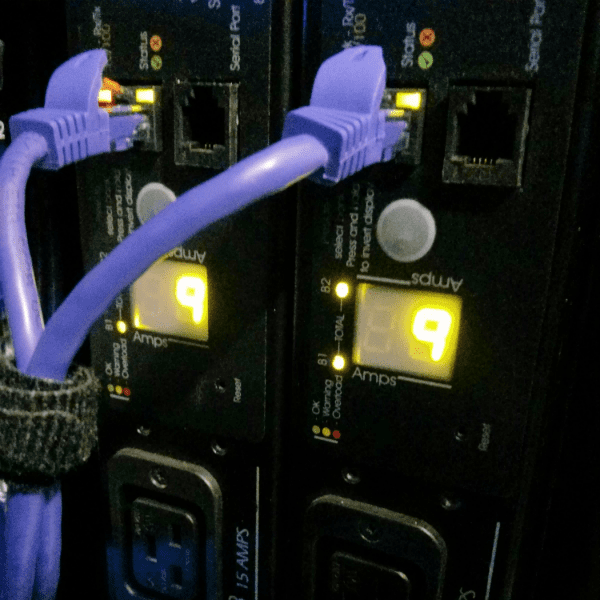
One of the hardest concepts when considering data center colocation is determining how much power equipment needs. There are many ways to find out what your power requirements are, but no matter what method you use, all computations involve three electrical concepts:
To calculate power draw, these electrical concepts are applied to a simple formula:
amps * volts = watts
This formula determines how much energy a piece of equipment uses at a given moment.
Most modern power distribution equipment has a built-in meter that displays the usage of power. In the PDU’s LCD readout below, you see can see both the primary and redundant PDUs are pulling 9 amps:

Manufacturers are also required to display acceptable voltage ranges and amps drawn per load on the faceplate of the equipment:

IT equipment like this usually accepts voltage ranges from 100-240 volts and is compatible with both 120-volt and 208-volt power. These particular PDUs are APC AP7941, which are rated for up to 30 amps on 208-volt circuits (80% of 30 amps according to the National Electrical Code for safety reasons). Because we know that the equipment plugged into the PDUs is pulling 9 amps, we can plug the values into the formula:
9 amps * 208 volts = 1,872 watts
The reason that we use only one of the 9-amp values is due to how primary and redundant power are configured. Primary and redundant power means two or more power supplies from different sources of power. Because the PDUs have the same gear connected to each, they should draw the same amount of power.
When planning for power redundancy, each circuit (primary and redundant) must be sized to handle the total load of both in case one fails.
We find that the cabinet’s equipment is pulling 1,872 watts (almost 1.9 kilowatts).
Make sure to leave wiggle room for “power creep,” as all IT equipment consumes more power over time.
If you don’t have a PDU with amp readouts, you can determine power requirements using a complete hardware list. You’ll have to research the manufacturer power specifications for each piece of equipment to determine:
For example, one of our customers might list the following pieces of equipment:
Let’s find our maximum power usage for all six pieces of equipment. First, we look up the manufacturer power specifications online to find:
So to determine the maximum power usage at any one time, we first have to convert everything into watts:
Then, add them together:
2200 watts + 320 watts + 360 watts = 2880 watts
The maximum amount power usage for these six pieces of equipment is 2880 watts.
Knowing the maximum power required provides a base to factor in how the equipment is used and how much real-world power needs to be provisioned. It’s important to note, however, that IT equipment rarely reaches its maximum power limit.
At Deft, we guarantee 100% uptime on power (and bandwidth!). Part of our unblemished success at doing so is the depth of discovery and analysis that our sales engineers undertake. The other part is the level of redundancies built into our data centers.
All it takes is a basic formula to right-size your power requirements. And if you need someone to double-check your work, you can always contact us.